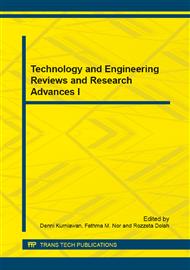p.3
p.8
p.13
p.19
p.26
p.31
p.36
p.41
p.50
Effect of Loading Rate on Indentation Behaviour of Fibre Metal Laminates Based on Kenaf/Epoxy
Abstract:
Kenaf natural fibre has become the subject of interest for a wide range of engineering sectors due to its biodegradable and outstanding mechanical properties. In this study, the effect of loading rate on the indentation behaviour of fibre metal laminates (FMLs) based on kenaf/epoxy subjected to static indentation loading was investigated. The fibre metal laminates were made of chopped strand mat (CSM) kenaf fibre with epoxy resin composite and 0.6 mm thickness of 1100-O aluminium alloy sheet by using vacuum infusion process (VIP) and hydraulic pressing technique. The experiments were conducted by using a universal testing machine with loading rate of 1 mm/min, 10 mm/min and 100 mm/min. The results of indentation resistance, energy absorption and corresponding indentation failure mechanisms were compared and discussed in this study. For 2/1 FMLs, the maximum contact force increased when the loading rate increased. The loading rate did not affect the indentation failure mechanisms of the 2/1 FMLs. However, for 3/2 FMLs, delamination occurred when the specimens were indented with loading rate of 10 mm/min.
Info:
Periodical:
Pages:
26-30
Citation:
Online since:
February 2015
Authors:
Keywords:
Price:
Сopyright:
© 2015 Trans Tech Publications Ltd. All Rights Reserved
Share:
Citation:


